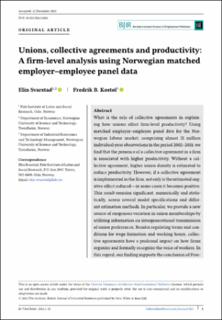| dc.contributor.author | Svarstad, Elin | |
| dc.contributor.author | Kostøl, Fredrik Bakkemo | |
| dc.date.accessioned | 2022-12-01T07:33:42Z | |
| dc.date.available | 2022-12-01T07:33:42Z | |
| dc.date.created | 2022-01-17T10:18:45Z | |
| dc.date.issued | 2022 | |
| dc.identifier.issn | 0007-1080 | |
| dc.identifier.uri | https://hdl.handle.net/11250/3035160 | |
| dc.description.abstract | What is the role of collective agreements in explaining how unions affect firm-level productivity? Using matched employer–employee panel data for the Norwegian labour market, comprising almost 21 million individual-year observations in the period 2002–2018, we find that the presence of a collective agreement in a firm is associated with higher productivity. Without a collective agreement, higher union density is estimated to reduce productivity. However, if a collective agreement is implemented in the firm, not only is the estimated negative effect reduced—in some cases it becomes positive. This result remains significant, numerically and statistically, across several model specifications and different estimation methods. In particular, we provide a new source of exogenous variation in union memberships by utilizing information on intergenerational transmission of union preferences. Besides regulating terms and conditions for wage formation and working hours, collective agreements have a profound impact on how firms organize and formally recognize the voice of workers. In this regard, our finding supports the conclusion of Freeman and Medoff that the quality of institutional systems is crucial to understand what unions do to productivity. | en_US |
| dc.language.iso | eng | en_US |
| dc.publisher | Wiley | en_US |
| dc.rights | Attribution-NonCommercial-NoDerivatives 4.0 Internasjonal | * |
| dc.rights.uri | http://creativecommons.org/licenses/by-nc-nd/4.0/deed.no | * |
| dc.subject | Produktivitet | en_US |
| dc.subject | Productivity | en_US |
| dc.subject | Fagforeninger og kollektive forhandlinger | en_US |
| dc.subject | Trade unions and collective bargaining | en_US |
| dc.title | Unions, collective agreements and productivity: A firm‐level analysis using Norwegian matched employer–employee panel data | en_US |
| dc.title.alternative | Unions, collective agreements and productivity: A firm‐level analysis using Norwegian matched employer–employee panel data | en_US |
| dc.type | Journal article | en_US |
| dc.type | Peer reviewed | en_US |
| dc.description.version | publishedVersion | en_US |
| dc.subject.nsi | VDP::Samfunnsøkonomi: 212 | en_US |
| dc.subject.nsi | VDP::Economics: 212 | en_US |
| dc.subject.nsi | VDP::Samfunnsøkonomi: 212 | en_US |
| dc.subject.nsi | VDP::Economics: 212 | en_US |
| dc.source.journal | British Journal of Industrial Relations | en_US |
| dc.identifier.doi | 10.1111/bjir.12662 | |
| dc.identifier.cristin | 1982272 | |
| cristin.ispublished | true | |
| cristin.fulltext | original | |
| cristin.qualitycode | 2 | |

